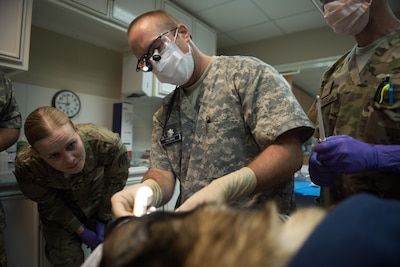By Air Force Master Sgt. Eric Sharman 386th Air
Expeditionary Wing
SOUTHWEST ASIA, Sept. 7, 2017 — In a deployed environment,
adequate medical care is crucial to ensuring people can execute the mission.
Airmen need to be physically and mentally healthy or the mission could suffer.
The 386th Expeditionary Medical Group boasts a medical clinic, physical
therapist, mental health team and dental clinic as just some of the services
paramount to keeping airmen mission-ready and in the fight.
But what do you do when an airman needs medical attention
and isn't a person?
This was a riddle that Army Capt. (Dr.) Margot Boucher, the
358th Medical Detachment officer in charge and veterinary doctor at the base
veterinary treatment facility, had to solve recently when Arthur, a military
working dog valued at almost $200,000, was brought to her clinic with a
fractured tooth.
"Arthur was doing bite training, bit the wrong way and
tore part of his canine tooth off, so he had a fracture to the gum line on one
of his strong biting teeth," Boucher explained. "The big concern with
that, in addition to being a painful condition, is that they can become infected
if bacteria were to travel down the tooth canal."
Boucher, a reservist deployed from the 993rd Medical
Detachment of Fitzsimons Army Reserve Center in Aroura, Colorado, works as an
emergency room veterinarian as a civilian. While she is well-versed in the
medical side of veterinary medicine, she said, she knew she wasn't an expert in
veterinary dentistry. To get Arthur the care he needed, Boucher reached out to
her Air Force counterparts at the 386th Expeditionary Medical Group for help.
"In this environment, I'm kind of all they've
got," said Air Force Lt. Col. (Dr.) Brent Waldman, the 386th Medical
Operations flight commander and dentist. "I've done four or five of these
on dogs, but I don't do these often. I felt very comfortable doing it, because
dentistry on a human tooth versus a dog tooth is kind of the same if you know
the internal anatomy of the tooth."
Waldman performed a root canal on Arthur, a Belgian
Malinois. The procedure involved drilling into the tooth and removing soft
tissues, such as nerves and blood vessels, to hollow the tooth out, Waldman
said. After the tooth was hollowed out and a canal was created, it was filled
and sealed with a silver filling. The procedure for Arthur was the same Waldman
would do on a human patient, he said.
"The reason why you do a root canal is because the
likelihood of there being an infection or other issue with that tooth is
significantly decreased," said Waldman, who is deployed from the 21st
Medical Squadron at Peterson Air Force Base, Colorado. "This is crucial
for a military working dog, because without his teeth, Arthur may be removed
from duty."
Military working dogs are trained to detect and perform
patrol missions which can involve biting a suspect to detain them or protect
their handler. This is why dental health is crucial.
"Those canine teeth are their main defensive and
offensive tools," Waldman said. "A dog with bad teeth, … it's like a
sniper having a broken trigger finger."
Help From the Veterinarian
While Waldman had experience doing dental procedures on
military working dogs, he still needed the expertise Boucher had in veterinary
medicine.
"Typically when we collaborate with human providers,
we'll still manage the anesthesia and the medical side of the procedure,"
Boucher said. "Usually if they are unfamiliar with the anatomical
differences, we'll talk them through that and familiarize them with the
differences between animal and human anatomy, but in terms of dentistry, it's
very similar. The procedure is the same, but the tooth is shaped a little
differently."
Prior to the procedure, Boucher conducted pre-anesthetic
blood tests to make sure 6-year-old Arthur didn't have any conditions
anesthesia would complicate. During the root canal, Boucher watched Arthur
closely and monitored his heart rate and blood oxygen saturation while making
minor adjustments to his sedation as needed.
The procedure was successful, and Arthur returned to his
deployed location with his handler a few days after. Were it not for the
interservice and interdisciplinary teamwork of Boucher and Waldman, Arthur and
his handler may have had to travel back to the United States to get the medical
care.
"It's a great service to be able to do," Waldman
said. "If we couldn't do this, Arthur and his handler would have probably
had to be taken out of theater to a location where they had the capability to
do this procedure. It saved a ton of time to be able to do this here and get
Arthur back to protecting our warfighters."

No comments:
Post a Comment